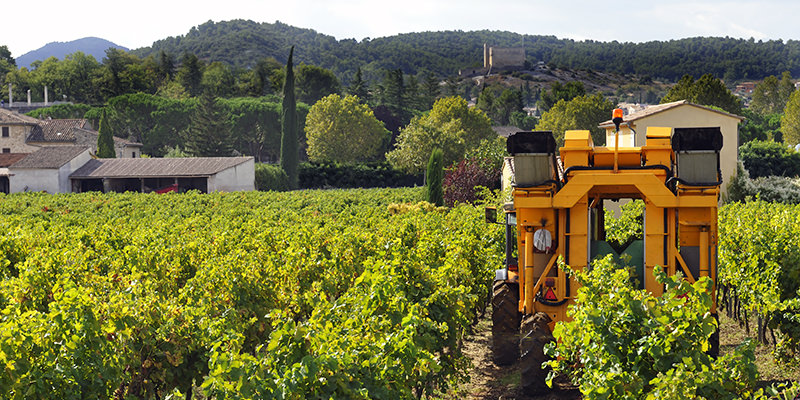Wine marketing does a great job making the biz look supremely romantic. A quick Google search reveals page after page of glamorous images, complete with golden-hour lighting and farm hands cradling grape bunches. Cue images of happy, slender couples on balconies and a never ending stream of bottle shots with vineyards in the background.
Unfortunately, the marketing that highlights “farm-to-table” aspects of wine — like hand-picking grapes — gives drinkers both an unrealistic view of the industry and an unfair bias against growers who use modern methods like mechanical harvesting in their vineyards. Instead of judging wineries, both small and large, that don’t hire dozens of workers to snip each ripe bunch from vines, it helps to understand the business side of the wine biz, and get an accurate picture of modern machine harvesting.
The wine business is at its heart a business, and nothing can happen if you can’t make a profit. For vineyard owners, this means the selling price of their grapes (either as fruit to wineries or in the form of finished wines) must be high enough to cover the costs of the season — pruning, labor, new grapevines, soil amendments, fertilizers, and the like. In 2015, UC Davis estimated that it costs about $4800 per acre to farm a vineyard in California’s Sierra Foothills, a rural and inexpensive growing area compared to more prestigious regions like Napa and Sonoma. In the foothills example, UC Davis estimated a sale price of $1,300 per ton for the grapes, meaning a vineyard needs to yield about 3.7 tons per acre to break even. Most vineyards average four to six tons per acre, making it easy to see that margins are slim in the best of scenarios.
Add in growing labor concerns across California, especially with crackdowns on immigration, and machines become even more attractive. Young Americans don’t want to pick grapes, and fast, skilled crews are expensive and hard to find. Vineyard workers average $10 to $12 per hour, though during busy harvest days they can make up to $16 an hour. That may sound like a bargain, but when it takes 20 people a month to harvest a large vineyard, the costs add up.
In comparison, a mechanical harvest machine is a bargain, even with their six-figure price tags. Estimates fluctuate across the industry, but mechanical harvesting costs somewhere between $100 and $300 per acre of grapevines, compared with a hand-harvesting cost of up to $750 per acre.
Despite how quickly these crews bring in grapes — a dozen workers often pick 20 tons of fruit per day — California produced 3.8 million tons of grapes in 2015 according to the USDA, and yields in 2015 were down by about 15 percent. If wineries had paid people to pick all of that fruit, $10 or $15 domestic wine simply wouldn’t exist. For wines that retail at $75 or $100 per bottle, the cost of hand-picking can be absorbed, but for the under-$20 segment that dominates sales, the math behind hand-harvesting just doesn’t add up.
Historically, the idea that machines damage fruit has led the charge against mechanical harvesting. It’s a perception that’s perpetuated through wine marketing, and one that has worked. Decades ago, when the first harvesters drove into the vines, that argument was legit, but today’s machines work quickly and gently. Modern harvesting machines move quickly through the vineyards, effortlessly slicing bunches from their branches. The bunches then fall into bins and are brought to the winery in the same fashion as hand-picked berries.
Praising hand-harvesting also fits nicely into current trends that highlight “farm-to-fork” cuisine and the idea that food producers should be small and farms tended by human hands. Viticulturist Chris Storm of Vino Farms in Lodi, however, allows his buyers to compare hand-picked and machine harvested fruit side by side to prove there’s no visible difference in grape quality. It’s comparisons like this that are driving even high-quality producers to switch from hand to machine harvests.
It’s easy to criticize large wineries, the vineyards of California’s Central Valley, or otherwise mass-market producers for mechanical practices, but their wines fill a critical space in the American market. Most often it’s inexpensive wines that introduce new drinkers to the pleasures of wine, and even keeps the cellars of seasoned wine lovers full. Whether you’re vehemently anti-Two Buck Chuck or regularly hunt for wine bargains, machines are responsible for making fantastic American wine available to the masses instead of an elite few. Next time you raise a glass, don’t worry about the technique, just worry about the taste.

